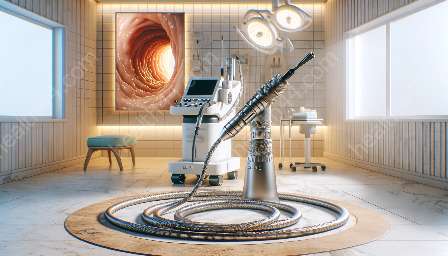Chromoendoscopy is a cutting-edge diagnostic technique that has revolutionized the field of gastroenterology. This advanced procedure is compatible with endoscopes and various medical devices, providing physicians with enhanced visualization and detection capabilities, leading to more accurate diagnoses and improved patient outcomes.
Understanding Chromoendoscopy
Chromoendoscopy involves the application of specialized dyes or stains to the gastrointestinal mucosa during endoscopic examination. These dyes help highlight specific abnormal tissue patterns, improving the detection of subtle lesions and abnormalities that may be difficult to visualize with standard white-light endoscopy.
One of the key advantages of chromoendoscopy is its ability to identify pre-cancerous and cancerous lesions with greater precision, allowing for early intervention and improved patient survival rates.
Compatibility with Endoscopes
Chromoendoscopy seamlessly integrates with modern endoscopes, enabling physicians to switch between standard white-light imaging and chromoendoscopy with ease. Endoscopes equipped with advanced imaging technologies, such as high-definition and narrow-band imaging, further enhance the diagnostic capabilities of chromoendoscopy, providing detailed and accurate visualization of the gastrointestinal mucosa.
Moreover, chromoendoscopy can be performed using both standard and therapeutic endoscopes, making it a versatile tool for a wide range of gastrointestinal procedures, including surveillance of inflammatory bowel disease, screening for colorectal cancer, and evaluation of gastrointestinal polyps and dysplasia.
Medical Devices & Equipment for Chromoendoscopy
Several specialized medical devices and equipment are essential for performing chromoendoscopy effectively. These include dye-spraying catheters, injection needles for submucosal injection of dyes, and control consoles for image enhancement and manipulation. Additionally, chromoendoscopy often utilizes advanced image processing software and video processors, allowing for real-time analysis and documentation of mucosal abnormalities.
The seamless integration of these medical devices and equipment with endoscopes ensures that physicians can conduct chromoendoscopy with precision and accuracy, maximizing the diagnostic potential of this transformative technique.
Benefits of Chromoendoscopy
The widespread adoption of chromoendoscopy has led to numerous benefits for both patients and medical professionals. By improving the detection and characterization of gastrointestinal lesions, chromoendoscopy has significantly enhanced the accuracy of diagnosis, leading to more targeted and effective treatment strategies.
Furthermore, chromoendoscopy has played a pivotal role in the early detection of dysplasia and neoplasia in patients with inflammatory bowel disease, helping to guide timely interventions and reduce the risk of disease progression.
Additionally, the integration of chromoendoscopy into routine screening and surveillance protocols for colorectal cancer has resulted in improved detection rates and early identification of precancerous lesions, ultimately contributing to a reduction in mortality and morbidity associated with this prevalent malignancy.
Potential Applications of Chromoendoscopy
Chromoendoscopy continues to evolve as a dynamic diagnostic tool with broad applications across various gastrointestinal conditions. Its potential applications extend to the evaluation of esophageal and gastric pathology, assessment of small bowel abnormalities, and surveillance of post-operative gastroesophageal reflux disease.
Moreover, ongoing research is exploring the utility of chromoendoscopy in the assessment of early-stage gastrointestinal cancers and the identification of microscopic lesions not visualized with conventional endoscopy. These advancements hold promise for improving the diagnostic accuracy and prognostic value of chromoendoscopy in diverse clinical scenarios.
Conclusion
Chromoendoscopy represents a remarkable advancement in gastrointestinal endoscopy, offering a powerful diagnostic tool that complements the capabilities of endoscopes and medical devices. Its ability to enhance the visualization and characterization of mucosal abnormalities has significantly impacted the field of gastroenterology, paving the way for more precise diagnoses and individualized treatment approaches. As technology continues to evolve, chromoendoscopy is poised to play an increasingly influential role in the early detection and management of gastrointestinal diseases, ultimately improving patient outcomes and shaping the future of endoscopic practice.


